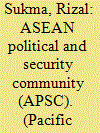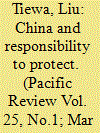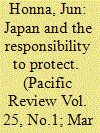|
|
|
Sort Order |
|
|
|
Items / Page
|
|
|
|
|
|
|
| Srl | Item |
| 1 |
ID:
110193


|
|
|
|
|
| Publication |
2012.
|
| Summary/Abstract |
Members of the Association of Southeast Asian Nations (ASEAN) took part in the World Summit 2005 and agreed to adopt the principle of Responsibility to Protect (R2P). However, there has not been any significant effort to discuss how the R2P might be applicable to the region and the issue remains a marginal one to ASEAN. However, the adoption of the ASEAN Political-Security Community (APSC) by ASEAN could provide a logical start for the maintraiming of R2P in ASEAN's discourse and practice. Some elements of the APSC appear to have characteristics in common with the R2P principle. While the APSC may provide broad and indirect support for building the capacity of States to recognise, prevent and respond to the situations of conflict, its immediate utility for preventing the four crimes of genocide, ethnic cleansing, war crimes and crimes against humanity nonetheless remains to be seen.
|
|
|
|
|
|
|
|
|
|
|
|
|
|
|
|
| 2 |
ID:
110194


|
|
|
|
|
| Publication |
2012.
|
| Summary/Abstract |
This article tries to analyze Chinese policy stance on the Responsibility to Protect (RtoP) concept from two levels: its basic attitude towards the core principles of this concept and its specific attitudes towards the execution of this concept, that is, the international intervention actions. Starting from the clarification of the RtoP concept, the article analyzes the maintenance and change of China's stance on state sovereign and non-interference principle. In the third part, four features of Chinese specific attitudes on intervention actions are abstracted, including cautiousness, aversion of military means, emphasis of UN authority and local support. Then the article further examines China's policy during the Libyan war, and finds that it basically follows the above framework.
|
|
|
|
|
|
|
|
|
|
|
|
|
|
|
|
| 3 |
ID:
110189


|
|
|
|
|
| Publication |
2012.
|
| Summary/Abstract |
While governments in Southeast Asia, together with other countries in the world, have shown their unanimous support toward the RtoP, the implementation of such principle needs more than just states' commitment. Since state actor, in many cases, is the perpetrator of crimes included in RtoP, the role of civil society is indeed crucial to put pressure toward the government to fulfill its responsibility to protect its populations. This article aims to describe Indonesia's position so far in responding to this RtoP principle. It tries not to cover only the government's position, but instead to also delineate the civil society's standpoint, which is an important element particularly, to provide a more comprehensive overview. As based on the latest elaboration of RtoP within the UN Outcome Document (2005) into three strategic pillars, it is interesting to observe whether both sides, the government and civil society are comfortable to recognise all pillars altogether or rather incline to take one or two pillars only. Nevertheless, robust development of civil society in Indonesia, as one of positive implications from process toward democracy has opened ample opportunities for the application of RtoP principle. Local NGOs that particularly focus on human rights issue have demonstrated the ability to put pressure on the government to exercise its responsibility as reflected in te first and second pillars. Since the government has stressed upon the importance of prevention to implement RtoP principle, the involvement of civil society is a must, particularly to carry out the role of early-warning to prevent the outbreak of mass atrocities that fall within the scope of RtoP, which can become another worthy discussion to elaborate. Finally, RtoP is all about implementation. Genuine political will from the government would be needed while partnership with the civil society element is nothing but important.
|
|
|
|
|
|
|
|
|
|
|
|
|
|
|
|
| 4 |
ID:
110191


|
|
|
|
|
| Publication |
2012.
|
| Summary/Abstract |
As the second largest contributor to the UN budget, Japan is expected to play a role in implementing the Responsibility to Protect (R2P). Why has Japan been unenthusiastic about actively engaging in the R2P discourse? What is the impact, both domestic and international, of incorporating R2P in its diplomatic agenda? In examining these questions, we first identify different perceptions about R2P among policy-makers and civil society in Japan. We then analyze the post-Cold War politics of diplomatic initiatives concerning Japan's human security doctrine. Third, we assess opportunities (and limitations) of synchronizing R2P with Japanese diplomatic agendas. Throughout the article, we argue that rather than distancing itself from R2P, as typically seen in official statements, actively embracing R2P may provide greater benefits for Japan both in terms of enhancing its diplomatic influence and mobilizing domestic political support.
|
|
|
|
|
|
|
|
|
|
|
|
|
|
|
|
| 5 |
ID:
110192


|
|
|
|
|
| Publication |
2012.
|
| Summary/Abstract |
At the 2005 World Summit, ASEAN Member States contributed to an official global consensus that states do indeed have a responsibility to protect their populations from the four mass atrocity crimes of genocide, ethnic cleansing, war crimes, and crimes against humanity. As is the case in a number of regions, however, there is a strong sense of caution - if not hostility - in Southeast Asia (and East Asia more broadly) towards the Responsibility to Protect's provision for military interventions as a last resort, in order to protect populations from such harm. Furthermore, there is an accompanying, more general ambivalence towards the perceived relevance of the norm for Southeast Asia, due to the perceived nature and/or intensity of conflicts in the region. Against this backdrop, this article attempts to shed light on a sub-altern discourse in the region that argues that the RtoP is not only relevant, but that it is critical it be operationalised in light of the various manifestations of conflict that plague the region.
|
|
|
|
|
|
|
|
|
|
|
|
|
|
|
|
| 6 |
ID:
110190


|
|
|
|
|
| Publication |
2012.
|
| Summary/Abstract |
There is growing interest among scholars and advocates in the way that the nascent norm of the Responsibility to Protect (R2P) is diffusing at the regional level. This article critically explores the spread of R2P in Southeast Asia against the backdrop of recent scholarship on norm localization. It argues that, contrary to some recent analyses, the R2P norm has not been localized in Southeast Asia. Constitutive localization requires the active borrowing of transnational norms by local or regional actors who build congruence with local practices. Although some regional states have used the language of 'sovereignty as responsibility' there are few signs that local actors are driving the reception of the norm in the region, nor have they institutionalized it. Rather, outsider proponents are the primary advocates and the norm lacks a champion or well-connected 'insider' proponent among regional governments or civil society groups. Second, despite an energetic campaign by advocates, emphasizing consensual and capacity-building activities, many governments are still wary of R2P as a potential threat to sovereignty and regime security. As a result, regional states have taken an 'à la carte' approach to R2P, accepting aspects of the R2P agenda that they find least threatening or that support their national interests, while ignoring or quietly resisting those they find challenging. Rather than localization, what we are seeing with respect to R2P in Southeast Asia is a dramatic change in the way outsiders are reframing the norm.
|
|
|
|
|
|
|
|
|
|
|
|
|
|
|
|
| 7 |
ID:
110188


|
|
|
|
|
| Publication |
2012.
|
| Summary/Abstract |
The inclusion of the three paragraphs in the Outcome Document of the 2005 World Summit that make reference to the obligations of the state and the international community under the principle of the Responsibility to Protect (RtoP) has effectively raised a challenge to the traditional understanding of the principle of sovereignty in international relations. More importantly, their inclusion in the Outcome Document has effectively committed its signatories to RtoP as briefly outlined in the Document. The question, however, is whether or not states will hold themselves to this commitment? Among the member-states of the Association of Southeast Asian Nations (ASEAN), the commitment to RtoP under the Outcome Document is clearly at odds with the oft-emphasized commitment to the principle of non-interference that the members of the Association have long identified with. The establishment of new institutional forms, mechanisms, and blueprints within ASEAN, however, create opportunities for introducing emergent norms into the region. The ASEAN Inter-governmental Commission on Human Rights (AICHR) is representative of these new institutional forms. It is the immediate manifestation of the ASEAN declaration of support for the promotion and protection of human rights in the region. Though criticized as "lacking in teeth" especially on the provisions that have to do with the protection of human rights, the AICHR's mandated functions are very generally ambiguous in the way they are presented in its Terms of Reference. These "ambiguities" arguably open up the interpretation of its functions to a more liberal perspective, more so in terms of opening the envelope on the protective functions of the AICHR. In the same context, the same ambiguities in the TOR of the AICHR may be utilized as entrypoints for introducing elements of RtoP into the region. It also illustrates the need to consider a strategy of incremental localization in pushing the normalization of RtoP in Southeast Asia.
|
|
|
|
|
|
|
|
|
|
|
|
|
|
|
|
| 8 |
ID:
110187


|
|
|
|
|
| Publication |
2012.
|
| Summary/Abstract |
The paper reviews Thailand's position on RtoP through in-depth interviews with those currently working most closely with RtoP-related issues within the Ministry of Foreign Affairs, the National Human Rights Commission, the Armed Forces and NGOs. The interview results reveal that Thailand's position on RtoP is mixed. While the country is willing to support the international community implementing RtoP through UN humanitarian operations, it is inclined not to define any of its own internal security problems as an RtoP-type situation. The paper highlights the challenges posed by separatist insurgents in Southern Thailand, and the recent violent political confrontation during April and May 2010, two internal security cases viewed by some observers as RtoP-type situations. But from Thailand's perspectives, almost all those interviewed insist that these situations are matters of internal security affairs. In addition, the preventive dimension of RtoP has not received much attention and has rather been challenged as to how such measures for the prevention of RtoP crimes differ from those more broadly undertaken to achieve the same goals as RtoP, but are not being called as such. Therefore, given the present context, Thailand's position on RtoP will unlikely change for the better if RtoP continues to be advocated as a concept in its current state.
|
|
|
|
|
|
|
|
|
|
|
|
|
|
|
|
|
|
|
|
|